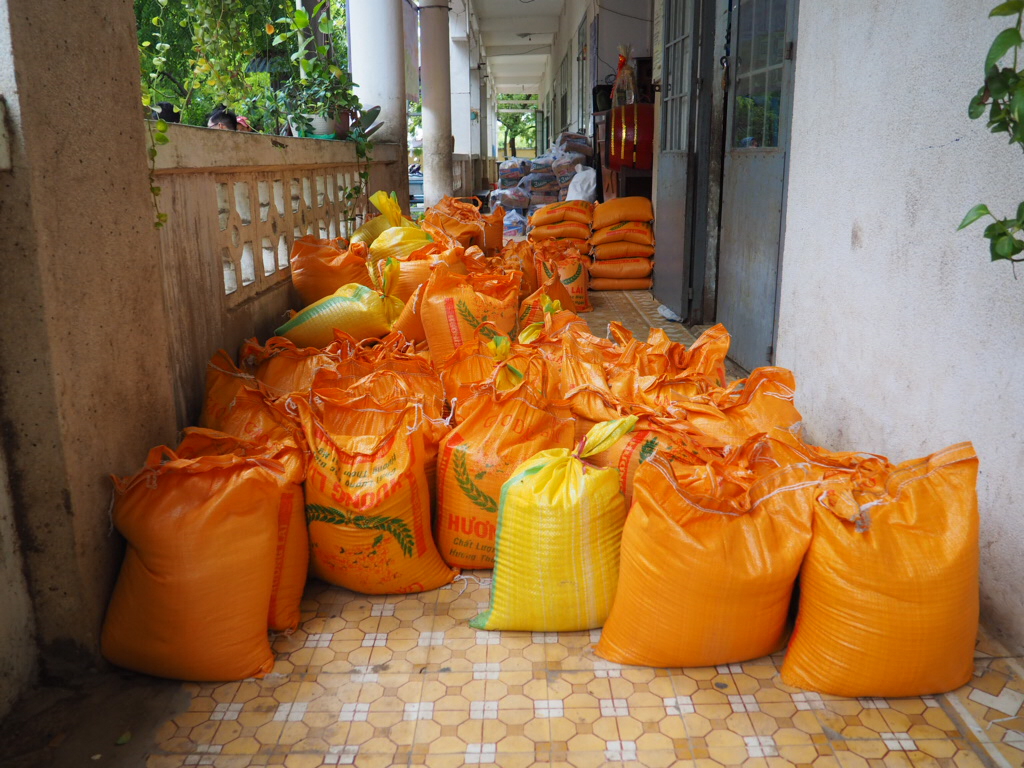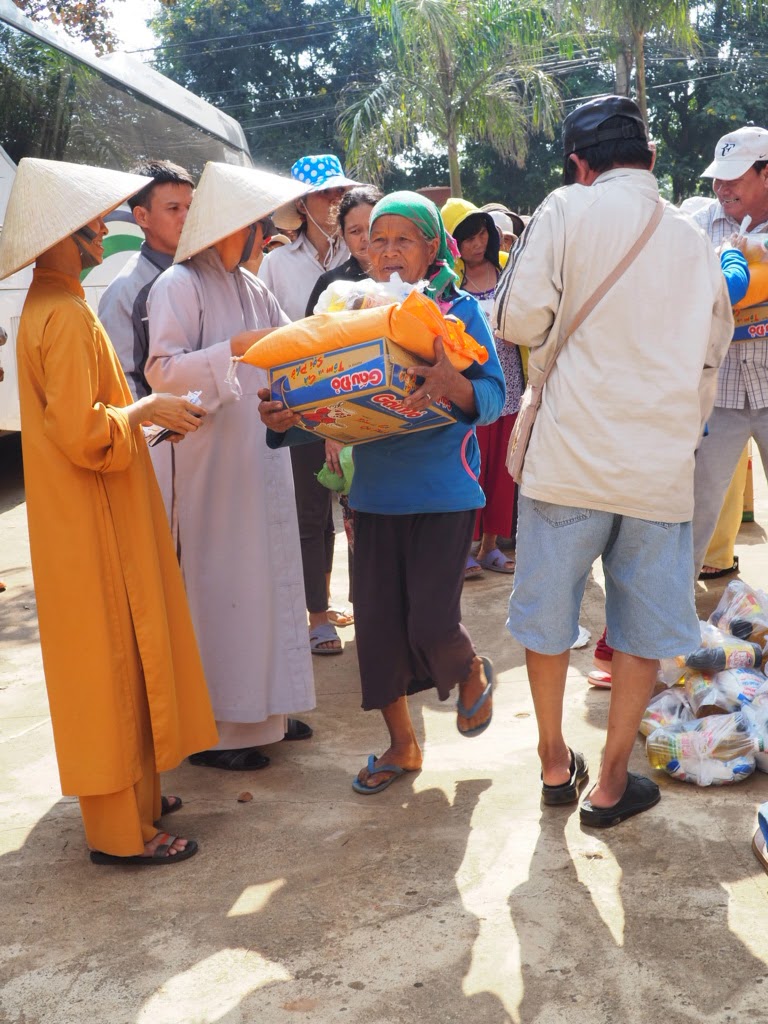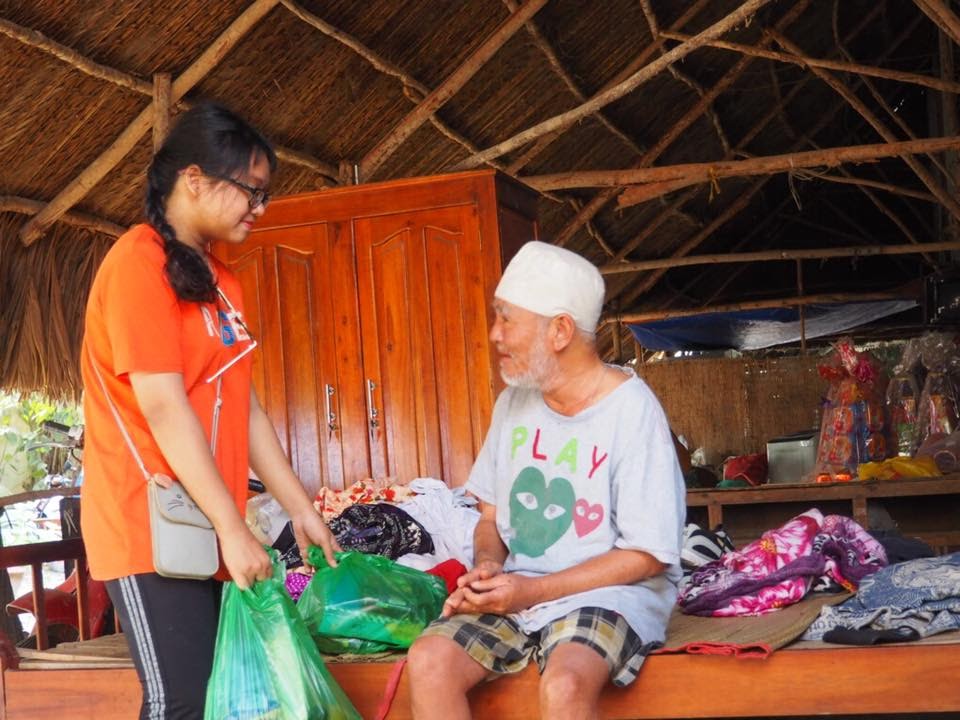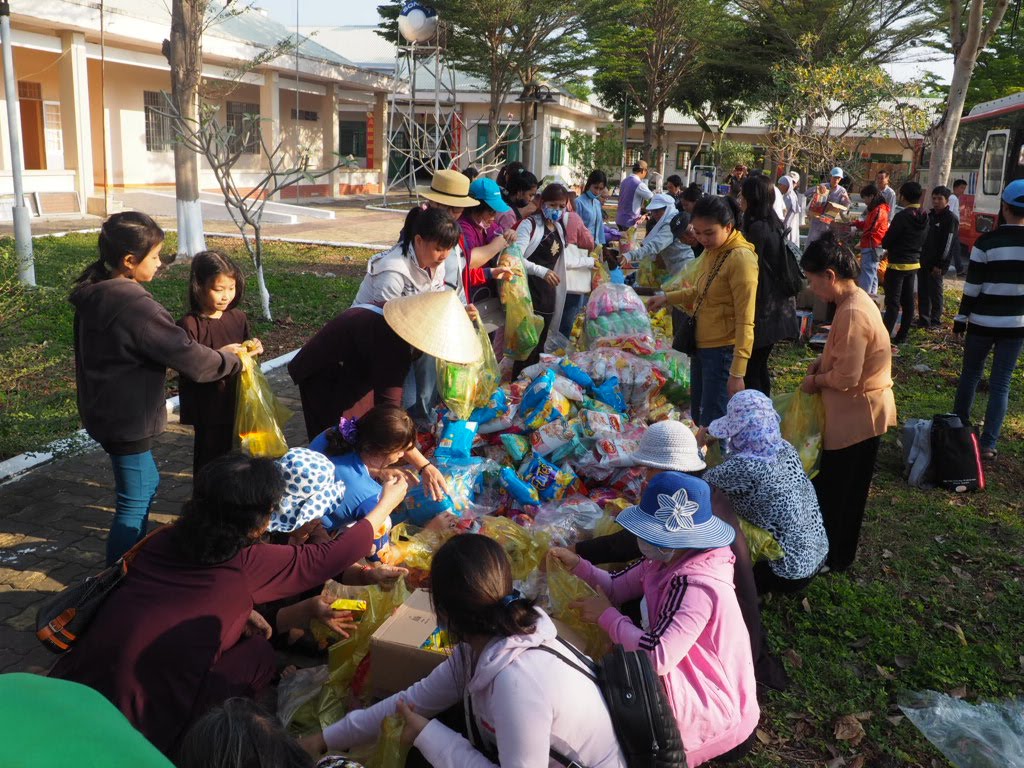Abstract: In this article, I use Emile Durkheim’s theory of “social facts” to examine Buddhist charity movements in Vietnam. Durkheim defines social facts as the beliefs and customs required to belong in a community. I use Durkheim’s theory to analyze how volunteer groups develop Buddhist cosmologies with distinct social facts about human subjectivity, ethics, and karma. My study traces how social facts cause different programming outcomes like decisions to serve meat-based or vegetarian meals among food charities. My findings are significant among studies of religious humanitarianism for suggesting that grassroots movements spread through heterogeneous values and cosmologies, even within a shared tradition.
Key Words: Vietnam, Buddhism, Karma, Food, Charity, Humanitarianism, Volunteerism, Durkheim, Social Facts
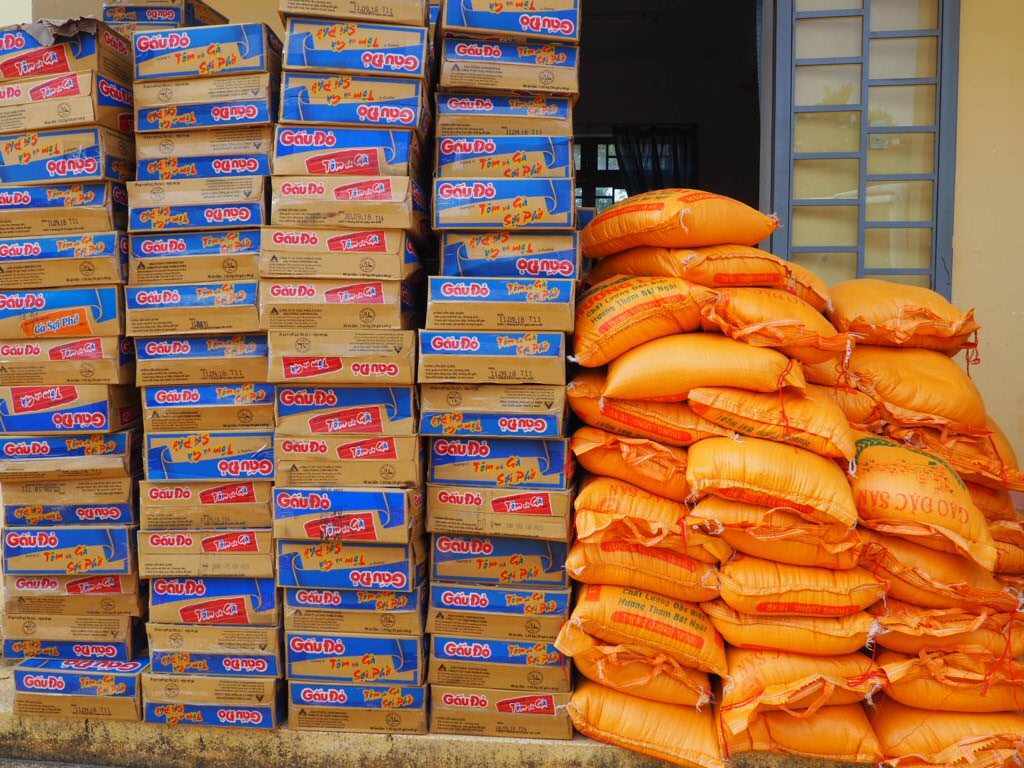
Introduction and Thesis
Pluralistic Approaches to Buddhist Charity in Vietnam
Religious humanitarianism is on the rise across Asia (Weller et al. 2018, 40, 48; Fountain and McLaughlin 2016, 10–12). Major studies have examined how religious volunteerism correlates with regional trends toward economic privatization and modernization (Bornstein 2012, 15; Huang 2009, 211; Weller et al. 2018, 10). Through volunteering, middle-class citizens can display their growing affluence and upward mobility while also demonstrating a moral investment in society (Nguyen 2018, 635; Jones 2009, 313). By sponsoring social services, religious groups can attract support from government policymakers as well as secular, inter-religious, national, and international donors (Samuels 2016, 61).1 Altogether, these studies show that volunteers and religious leaders increasingly use charity both (1) to address rising humanitarian needs and (2) to gain social status and moral authority in changing societies.
Trends toward religious humanitarianism are especially prominent in Vietnam, where Buddhism-based charities have become the second-most common providers of social services after the state (Hoang et al. 2019, 1076). Since the 1986 policy reforms known as Đổi Mới, the communist government has advanced legislation promoting private development and downscaling public services.2 In 2013, the government began offering “tax and fee reductions” for “faith-based organizations which provide services for underserved populations” (Hoang et al. 2019, 1078). Buddhist institutions in the Mahayana-majority country readily responded to these incentives.3 Today, Buddhism-based organizations provide a wide range of services, such as care for orphans and the elderly, low-cost traditional medicine, free meals, and mental health support (Hoang et al. 2019, 1076; Nguyen 2016). These charities ultimately respond to emerging calls from policymakers for socialist citizens to use private wealth to support one another (Nguyen 2018, 634).
In recent years, the booming popularity of “doing charity” (làm từ thiện) has attracted considerable attention in local news and scholarship (Nguyen 2018, 635; Le 202, 6). However, anthropologist Le Hoang Anh Thu notes that:
Studies exploring charitable practice in contemporary Vietnam… tend to focus on organization-based charity and have thus paid insufficient attention to grassroots charitable giving. Studies on faith-based charity in Vietnam have highlighted the activities of religious institutions, such as the Vietnamese Buddhist Sangha or significant temples in the country, rather than spontaneous charitable events organized by lay practitioners (2020b, 6).
Informal, ad hoc, and grassroots charities have similarly gained widespread popularity, yet the economic and social impacts of these movements are virtually unmeasured. Furthermore, few studies consider the reasons that compel everyday people to give their time, energy, and financial resources to these informal and often spontaneous humanitarian efforts. Qualitative research on grassroots charities can help scholars answer the questions: who is doing all of this volunteering, and why?4
Ad hoc food charity appeals to volunteers across social classes and income levels (Le 2020b, 7; Swenson 2020a, 7). Analyzing food charity therefore provides an organic entry into comparative studies of volunteerism. Comparative studies of class, gender, sexuality, ethnicity, race, ability, education levels, political connections, and other demographic factors are necessary to consider how people from diverse social contexts (1) become involved in volunteering and (2) collaborate in actualizing charity projects. Among studies of religious humanitarianism, comparative research can also highlight how nuanced differences in spiritual practices and interpretations of religious cosmologies shape local forms of charity.
In this paper, I argue that diverse understandings of karma correlate to different programming styles among volunteer groups.5 My study is based on twenty months of fieldwork conducted between 2015 and 2019 in Vietnam’s fastest-growing urban area, Ho Chi Minh City—often colloquially known as Saigon. This article features a juxtaposition of ethnographic data from three Buddhism-based food charities to show how subtle distinctions in religious cosmologies of karma have broader material effects on community projects and events.6 I use Emile Durkheim’s theory of “social facts” as a method to analyze how charity groups cultivate distinct understandings of Buddhist ethics, human subjectivity, and karma that subtly influence their programs.
Through the following pages, I first describe common approaches to karma and the ethics of food charity among Buddhist communities in Vietnam. I then define Durkheim’s theory of social facts and argue that this method of analysis can illuminate how seemingly homogenous grassroots movements are highly pluralistic. Next, I describe examples from three food charities in Ho Chi Minh City, highlighting how members of each group create distinct sets of social facts about karma, ethics, and subjectivity. I trace how these social facts influence material forms of charity, particularly decisions to serve vegetarian or meat-based meals to recipients. The conclusion section compares these findings with other major studies of religious humanitarianism to emphasize the importance of ethnographic research for understanding the pluralistic qualities of charity movements in Asia.
Understanding Karma
The lay and monastic volunteers I interviewed all framed charity as valuable for making merit and affecting karma. “Karma” (nghiệp chướng; nghiệp báo) is a Sanskrit word that means “action” and derives from all activities of the “body, speech, and mind” (thân, khẩu, ý) (Lopez 2009, 259). Karma results from the cumulative effect of actions across one or more “incarnations” within cycles of samsara (kiếp luân hồi). Samsara is the system of birth, death, and rebirth through which all “sentient beings” (chúng sanh, chúng sinh) move, unless “liberated” (giải thoát) through “awakening” (giác ngộ), often called “enlightenment” in English. Throughout the history of Buddhism, diverse schools have debated the nature of awakening as well as the relationship between karma and enlightenment. Doing good deeds, such as practicing charity, are generally understood to make “merit” (công đức) or “blessings” (phước đức) that create positive effects on karma (Ohnuma 2007).
In the context of contemporary Vietnam, the volunteers I met used these common terms of karma, merit, and collective being, but disagreed on the scope to which karma physically shapes daily life and experiences of reality. Many followers of popular, non-orthodox or “contra-modern” Buddhism asserted that karma has concrete, material effects on one’s current and future life conditions (Swenson 2022). Good karma produces benefits such as health, wealth, beauty, and high social status. Bad or “heavy karma” (nghiệp nặng) produces consequences such as poverty, illness, unattractiveness, or low social status. From this perspective, making merit can concretely improve one’s karma and the karma of others.7 Subsequently, doing charity can lead to miraculous changes in one’s life, relationships, and health. These changes may be so comprehensive, sudden, or improbable that they are inexplicable through the laws of natural science.
By contrast, among increasing movements toward modern Buddhism, which began to develop in Vietnam around the 1920s, practitioners interpreted karma as more individualistic and metaphorical (DeVido 2009; Soucy 2020, 65). Karma is rationalized as the social or physical consequences of an action, bound by the laws of natural science. This scientific approach frames karma as a figurative teaching tool, rather than a force that shapes reality. Similarly, modern approaches to karma tend to reduce the role of samsaric temporality, focusing more on ethical actions in “this life” (kiếp này) rather than theorizing about the effects of actions in past or future incarnations. From this perspective, doing charity benefits donors and recipients by supporting civil society and immediately mitigating humanitarian needs—outcomes validated by secular, scientific assessments rather than an appreciation of inexplicable miracles.
The volunteers featured in this article primarily described karma in popular, contra-modern terms, yet with awareness to the more modern, orthodox teachings promoted by elite monastic leadership. Even as volunteers maintained non-orthodox approaches to karma, their understandings of how to best improve or influence karma still differed by group. Altogether, these findings suggest that understandings of karma among volunteers did not follow one systematic ideology or universal Buddhist doctrine but were shaped through discursive and affective group interactions, nuanced by the demographic makeups of each charity community.
Defining “Social Facts”
Durkheim’s theory of “social facts” provides a useful method of analysis to consider how volunteer groups cultivate these distinct approaches to karma and Buddhist ethics. Durkheim defines social facts as the obligatory norms, customs, behaviors, and emotional orientations that individuals assume in order to be members of a society (1950, 1). Social facts exist at both macro and micro scales—they derive from and perpetuate nationalities, legal systems, languages, currencies, religions, social classes, and every day “moral maxims” (Ibid., 2). At each scale, social facts are “endowed with coercive power” that encourages belonging and enforces cooperation within any given community (Ibid., 2).
My use of Durkheim’s theory places less emphasis on the “coercive power” or obligatory pressure of social facts. Durkheim himself suggests that social facts can be so totalizing that they are like the atmosphere pressing down on Earth—constant and familiar enough that “we no longer feel [the] weight” (1982, 53). Yet, this weight still has an effective force. An individual influenced by the social fact of, say, a “common emotion” may be subsumed by this “social influence” to the extent that they “no longer recognize themselves” and act out of character (Ibid.). Under these circumstances, morality becomes difficult to distinguish from social facts and cannot be negotiated. As James Laidlaw asserts, “Durkheim’s conception of the social so completely identifies the collective with the good that an independent understanding of ethics appears neither necessary nor possible” (2002, 313). Scholars of moral anthropology such as Laidlaw (Ibid.), Joel Robbins (2007), and Jarrett Zigon (2007), refer to this conflation between morality and society as “the Durkheimian collapse” (Cassaniti and Hickman 2014, 256).
Cassaniti and Hickman trace how anthropologists of morality have sought to resist this “Durkheimian collapse” by theorizing morality and ethics through agency. They propose that morality changes and develops amid moments of “deliberate free choice” apart from “social reproduction” (Ibid., 258). While this approach seeks to distinguish morality from totalizing social norms, it does so by privileging individual agency and choice over conformity. Scholars like Saba Mahmood have, in turn, critiqued such definitions of agency as free choice for subtly promoting liberal values of individualism (2009). Mahmood advocates for studies of agency that, instead, examine practices or behaviors that create change beyond cognitive choice, and that include self-disciplining practices toward shared identities rather than toward individualism.
My study proposes a balance among these approaches to both social facts and agency. Rather than considering social facts at the macro-scale of nations, languages, or global religions, I instead consider the shifting politics of social facts among micro-scale urban communities. Approaching social facts at this scale also allows me to examine how community members practice moral agency by creating affective bonds with one another and by comparing their own social facts against the social facts of other communities.
I find Durkheim’s theory helpful for illuminating how community members—even within a shared cultural context or religious tradition—may refer to the same cosmological concepts, yet understand and experience these concepts in different ways. Durkheim explains these discrepancies by observing that social facts may share root causes yet function to “serve different ends” (Ibid., 91). “Thus,” he states, “the same words may serve to express new ideas” (Ibid). While Durkheim’s work has been critiqued for its totalizing treatment of social facts, my reading also highlights ways that his original theory may allow for more discrepancies, differences, and change than anthropologists of morality have previously acknowledged.
I adapt Durkheim’s theory to demonstrate how charity groups generate “collective tendencies” toward different styles of giving by cultivating distinct “social facts” of Buddhist cosmology (2005, 274). These collective tendencies accumulate through shared experiences and relationships (Ibid., 274), which—over time—coalesce into what Durkheim calls “a system of realities” (Ibid., 275). I argue that diverse social facts of Buddhism thus produce concrete, material outcomes, such as distinct forms of charity practices.
Next, I offer a series of ethnographic vignettes from three different food charities. These vignettes show how volunteer groups curate their own social facts about human subjectivity, karma, and the effects of generosity.
Ethics and Effects of Giving: Three Examples
Vegetarianism and the Spirit of Generosity at Dharma Flower Pagoda
On a sunny afternoon in July 2018, I hailed a motorbike taxi to visit Dharma Flower Pagoda on the outskirts of Ho Chi Minh City. The pagoda8 was a small house that had been converted into an unofficial monastery by the abbess, Master Clarity, in 2005.9 The temple was still waiting approval and recognition by Vietnam’s state-managed National Buddhist Sangha (Giáo hội Phật giáo Việt Nam), but already thrived as a center of religious activity for the neighborhood. Every day, four to six resident nuns, ages 20 to 55, led chanting rituals for local devotees. The nuns also sponsored annual holiday festivals and regular food charity drives. Each month, Master Clarity called for donations of rice, oil, and instant noodles to redistribute to poor families in the neighborhood. A younger nun, Sister Radiance, frequently collaborated with a group of college students to cook and deliver meals for homeless people in the nearby Gò Vấp district.10 These modest programs were intended to support the pagoda’s immediate community. Yet, despite the limited scope of their charity work, the monastics of Dharma Flower had a city-wide reputation for their sincere generosity. A nun at a more prominent pagoda in Saigon’s central Bình Thạnh district recommended Dharma Flower as a community of people who performed charity “with heart” (có tâm) in keeping with Buddhist teachings.
When I arrived at the temple to meet Sister Radiance, she invited me into a small common room where a table was set with a pot of tea and a plate of cashews. “So, would you like to interview me?” she asked, laughing, then added, “It will be very easy for me. My answers are very simple.” She explained that she does charity and then “forgets it.” She doesn’t think about it anymore.
She poured our cups of tea and we sat down. I followed her opening quip by asking what it meant to do charity “with heart.” Sister Radiance responded that the scale of charity was not as important as the “spirit” (tinh thần). Her own work feeding the homeless was meant to both share food and “share happiness” (chia sẻ hạnh phúc) with vulnerable people. She proposed that spiritual generosity “helps (recipients) feel and see that someone out there is paying attention.” Sister Radiance emphasized that this attitude was the source of giving “with heart.” By comparison, she postulated that some volunteers got caught up in assessing prospective recipients or judging their needs (by, for example, refusing to give meals to people who appeared drunk or physically capable of working to sustain themselves). This implied that, on some level, volunteers viewed themselves as better or more moral than recipients, and therefore able to determine who deserved free food. Instead, giving with heart required deferring one’s own status and feelings in order to “pay attention” (quan tâm) with all one’s strength or “capacity” (hết sức) to the recipient. True charity could involve giving material goods, but always required the emotional and spiritual components of smiling, sharing happiness, and “encouraging” others to be “fearless.”11 Fearlessness might range from inspiring hope despite extreme poverty, or encouraging recipients to be courageous in making beneficial life changes, like overcoming alcohol dependency.
Sister Radiance’s dual references to alcoholism repositioned her hypothetical charity recipient from one who was judged and rejected for drunkenness, to one who was seen and supported for long-term recovery from addiction. This repositioning occurred wholly on the part of the donor. Volunteers who gave in the spirit of generosity understood that charity was comprehensive—attuned to the holistic emotional and physical wellbeing of recipients—rather than focusing on the superficial equation of an exchange.
Sister Radiance continued by explaining that the spirit of giving came more naturally as followers “learn about the Buddha’s teachings.” In her own case, she had never done charity before being ordained as a nun. Once ordained, however, she became vegetarian. Becoming vegetarian “changed her way of thinking.” She began to regard not only other animals and insects as possible family members from a past life, but soon also saw other people as her relatives. This change in mentality affected her orientation to the world in a way that compelled her to constant, small acts of generosity and care. “So,” she concluded, “It’s not that I do a lot of charity, but I do charity in many different ways.” Sister Radiance’s approach to charity was subtly echoed by the abbess, younger nuns, and student volunteers at Dharma Flower Pagoda throughout the following year as I attended food donations, ordinations, and charity tours with their community.
Throughout this conversation, Sister Radiance took a range of ethical stances toward the relationship between donors and recipients. First, charity should be given without assessment of the recipient, then forgotten by the donor. Second, charity should be given with a singular focus on the perceived needs of the recipient. Finally, charity should be performed through a sense of trans-temporal kinship with recipients. The continuities among these ethical positions were a selfless orientation to giving and a sense that this selfless orientation was made possible through one’s spiritual state. Changes to one’s spiritual state included heightened attentiveness to intersubjective connections among sentient beings. These connections transcended a limited focus on the present life, broadening the donor’s scope of awareness to multiple incarnations. This broader temporal scope ideally allowed the donor to perceive connections with sentient beings, uninhibited by biases around human social classes or hierarchies between species.
Volunteers at Dharma Flower Pagoda encouraged this ethical orientation by advocating both for charity and vegetarianism in everyday life. The way the nuns of Dharma Flower advocated for vegetarianism distinguished them from other monastics in Saigon and surrounding rural provinces of the Mekong Delta. By comparison, I spoke with nuns at other pagodas who joked and bemoaned that vegetarianism was the hardest part of being a monastic, or who proposed that vegetarianism was an inappropriate practice for lay people, as it suggested an air of moral superiority equal to those who had taken monastic vows. The nuns of Dharma Flower not only maintained strict vegetarianism themselves, but also advocated for vegetarianism among their lay followers. This advocacy extended to the food charities they organized and hosted at the pagoda. The college students who met at Dharma Flower also prepared only vegetarian dishes to distribute to the homeless, on the grounds that these dishes were healthier, more nutritious, and guaranteed to have safe, “clean” (sạch) ingredients. While, as Sister Radiance proposed, donors should not try to assert moral authority over charity exchanges by judging or screening recipients, the college students maintained that donors were morally responsible for their consumer decisions in purchasing ingredients for charity. Serving vegetarian meals was intended to both limit harm to animals and subtly encourage less meat consumption as an ethical practice with positive spiritual implications for donors and recipients alike.
Volunteers at Dharma Flower Pagoda emphasized generosity as a form of care and merit-making that exceeded the boundaries of “this lifetime.” Karma functioned as a social fact that oriented volunteers toward trans-temporal and trans-species kinship. This broader orientation also emphasized ethics of selflessness by reminding donors that the perceived goals, needs, and relationships that dominate “this life” are limited. Cultivating a higher spiritual status by learning about Buddhism and adopting ethical practices like charity and vegetarianism creates a mutually reinforcing feedback loop. As volunteers become increasingly dedicated to altruism, selflessness comes more naturally, further enabling one to sustain these ethical practices and cosmological orientations from moment to moment. Giving vegetarian meals for recipients thus becomes the most logical and moral programming decision possible within the “system of reality” created by these social facts of human subjectivity and samsaric temporality.
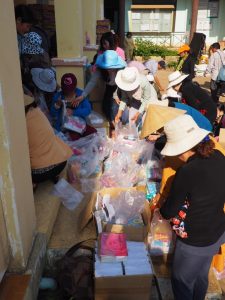

Figure 2: The nuns of Dharma Flower Pagoda organize a holiday food drive for ethnic minority communities in Vietnam’s central highlands.
The Merit of Meat: Cooking as Care in the Sunshine Volunteer Corps
Throughout my research, I also connected with food charities that did not share Dharma Flower’s conviction that vegetarianism was an essential ethical practice. One of these groups was a community of lay people called the Sunshine Volunteer Corps. Sunshine charity events attracted approximately 30 volunteers per event, usually evenly divided by gender and ranging between 20 to 40 in average ages. In the early years of the organization, volunteers came from a blend of middle-class, upwardly mobile, and working-class backgrounds, with careers as business managers, shop owners, mechanics, house cleaners, and day laborers. In more recent years, from 2015 to 2023, the demographics of the program shifted to more middle-class and wealthy volunteers, particularly attracting young business managers and college students.
From 2012 to 2020 (when regular programming was disrupted by the Covid-19 pandemic), members of the Corps met once a month to prepare up to 1,500 meals for cancer patients at the public Ho Chi Minh City Oncology Hospital (Bệnh viện Ung Bướu). These volunteers prided themselves on offering a delicious signature dish of roast pork. The group’s main organizer, a lay man in his 30s named Bảo, proposed that this signature dish was both nutritionally valuable and showed sincere care for cancer patients. Rather than buying cheaper ingredients or ready-made meals, Sunshine volunteers were meticulous in purchasing pork from clean, trusted sources. Corps members then stayed awake overnight before distribution events home cooking and preparing meals by hand.12
Frequent participants, like a 33-year-old internet technician named Vũ, stated that such acts of charity created karmic benefits for both volunteers and recipients. Vũ conceptualized karma as mutually compounded between human interactions. Heavy karma became “self-perpetuating” by causing misfortune and compelling people to behaviors that further harmed others, such as deception, theft, or violence. Conversely, meritorious actions simultaneously benefitted donors and recipients. Volunteers gained the blessings of merit by striving to alleviate suffering, while recipients benefitted by responding to generosity with positive feelings of “happiness” (hạnh phúc) or “joy” (niềm vui). These positive feelings also helped to counteract negative feelings of “worrying” (lo lắng) or “anger” (tức giận) that caused or exacerbated illness.
Volunteers with other Buddhist charities that operated in and around the Oncology Hospital were sometimes critical of the Corps’ decision to serve meat. These critiques featured concerns that food charity was simply an attention-seeking act that drew praise for donors without actually benefitting cancer patients. The Corps’ signature pork dish might make their charity popular among recipients who were culturally accustomed to eating meat. but meat consumption was inherently unhealthy, especially for those already battling terminal illness. Furthermore, lay Buddhists with other organizations purported that serving meat produced negative karmic repercussions for both donors and recipients by promoting the killing of animals. When I relayed these critiques to Bảo and asked for his opinion, he casually rebuffed them. He explained that the Corps chose its ingredients with careful scrutiny to avoid food tampering, growth hormones, and other health risks associated with unknown sources (see Faltmann 2019). Each dish was then cooked with loving care and served with compassionate intentions. Bảo argued that meat provided nutrients necessary for energy, strength, and healing. Therefore, the karmic implications for serving meat were far more complex than a simple formula of right versus wrong.
Like volunteers at Dharma Flower Pagoda, members of the Sunshine Volunteer Corps also understood karma and merit as highly intersubjective. However, the scope of these intersubjective relationships did not extend immediately to animals or non-human entities. Sunshine volunteers kept their ethical focus on supporting human health, which they argued required the nutrients provided by meat consumption. These perspectives reflected a more modernist, rationalist approach to human-animal relations, even as they promoted an unorthodox, popular understanding of karma as collective.
Corps’ members cultivated and circulated social facts of karma as having concrete effects on the material world, similar to the nuns of Dharma Flower Pagoda. Both communities held that doing good could produce physical effects of positive change and healing, from ending alcoholism to curing cancer. Similarly, in both groups, an important measure of sincere generosity was the emotional orientation toward selfless care for others. However, these findings show that the subtle differences in how volunteers prioritized relationships with humans or animals within systems of karma fundamentally influenced the types of food they provided. While both groups promoted food charity movements across the city, they held antagonistic attitudes toward one another’s programming decisions. These tensions demand a more pluralistic approach to analyzing religious food charity movements across the region.
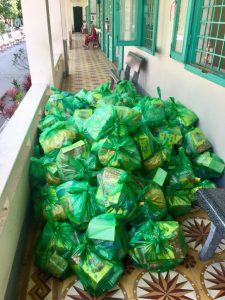
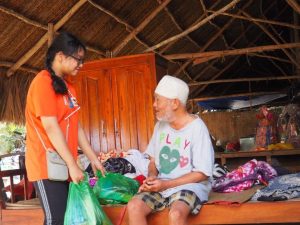

Feeding the Homeless through Hồng’s Facebook Page
In addition to attending the Sunshine Volunteer Corps’ monthly events, I accompanied ad hoc meal distributions organized by a single mother in her 40s named Hồng. Unlike Sister Radiance and Bảo, Hồng felt more ambivalent toward organized religion and institutional Buddhism. She was generally skeptical of Buddhist leadership in Vietnam. She suspected many monastics were drawn to ordination to gain social status and political connections, not to follow Buddhist teachings. However, Hồng’s still upheld and advocated for ideals, values, and sensibilities informed by popular Buddhist cosmology. She speculated that karmic bonds created “predestined affinities” (nhân duyên) between people and felt that positive changes to society might come by improving karma for all “sentient beings.” Rather than visiting pagodas, chanting, or studying Buddhist scriptures—common practices performed by many lay followers—Hồng instead sought to improve karma and transform society by doing charity on her own terms.
Around 2008, Hồng began hand-preparing meals to distribute to homeless people along her work commute through Phú Nhuận district. Over the next ten years of volunteering, Hồng began to film herself live over Facebook while preparing the meals and invited social media contacts to help her with food distribution. By 2019, Hồng was giving away thousands of meals each month—approximately 200 boxes at a time—through these spontaneous, semi-weekly events. Many of the friends and acquaintances who volunteered to distribute her meals were similarly skeptical of institutional Buddhism. Yet, like Hồng, they maintained that karma produced concrete, material consequences in the world and that the results of karma could be positively influenced by benevolent actions.
Similar to the Sunshine Volunteer Corps members, Hồng served meat with her free meals. She prepared roasted chicken and rice with the rationale that it was more nutritious and delicious than vegetarian food. Giving vegetarian food to the homeless, she felt, was a self-centered form of moral posturing. Homeless people might open a box of vegetarian food and feel “disappointed” by the contents. Instead, Hồng aspired to give “joy” (niềm vui) and “smiles” (nụ cười) to “destitute people,” by offering them a bit of “warmth” (ấm áp) on cold nights. Hồng’s allusion to giving warmth carried the double meaning of literally offering hot meals and metaphorically offering attentive care.
While Dharma Flower Pagoda and the Sunshine Volunteer Corps were relatively tightknit communities that attracted regular volunteers, Hồng’s charity group was significantly more fluid. The ad hoc nature of events meant that each food distribution attracted different networks of volunteers for virtually every gathering, depending on participants’ availability, interest, and chance scrolling through Facebook. The social-media driven nature of Hồng’s program also invited more public commentary on her events. This commentary led to direct questioning of Hồng’s ingredient choices, whereas Corps members experienced these critiques more obliquely through roundabout gossip. For example, in May 2019, when confronted for her choice to serve meat through Facebook comments, Hồng responded with a public post rebuffing the criticism saying, “Don’t criticize… I make free chicken and rice for ‘poor people’ (người nghèo), but a number of friends are saying ‘how come you don’t make ‘vegetarian food’ (cơm chay) for merit? If you want merit, then you do it. If you’ve never yet ‘given charity’ (bố thí), then stop typing nonsense to lessen your karma.”
For Hồng, sincere charity required an immediate orientation toward “the little things that people need right now.” This orientation affected her programming style by reinforcing a preference for ad hoc, spontaneous cooking and social-media driven events. Cam, a house cleaner in her 30s who often participated in Hồng’s food distributions, suggested that Hồng’s giving was more sincerely selfless precisely because of its spontaneity. Hồng rejected any labels of herself as a “leader” or “organizer”—instead, she modestly downplayed her role by calling attention back to the perceived needs of her poor and homeless meal recipients. By assuming this attitude, Hồng performed the selfless ethic of leadership that she felt was lacking in formal Buddhism. The social facts of karma that coalesced around Hồng’s charity thus favored spontaneous, heartfelt giving over premeditated formal programming. Hồng’s community granted greater moral authority to non-elite lay people, whom they felt were in a better position to fulfill Buddhist ethics of generosity without any thought of reciprocity—not even the soft reciprocity of spiritual authority granted to monastic leaders.
Like Sunshine volunteers, Hồng’s social facts of karma and altruism blurred modern and popular forms of Buddhism. Her emphasis on individual morality, intentions, and feelings resonated with modernistic concepts of autonomous personhood. Yet, her highly inter-subjective, almost mystical, understanding of karma reflected popular beliefs that merit can immediately improve material reality. Hồng’s subject position as a working-class lay woman and single mother—skeptical of the mainstream social institutions and religious organizations that she felt rejected her—led her to hybridize available modern and non-modern Buddhist worldviews in crafting a set of social facts around food charity that appealed to countless social media followers.
Conclusion: The Social Facts of Food Charity
These three examples show how social facts of karma affect understandings of human subjectivity, temporality, and the ethics of food charity. Across groups, volunteers used similar language of selflessness and empathetic care to explain their distinct programming styles. As Durkheim notes, these terms may share a broader historical or cultural source while still functioning differently in each community. The heavy emphasis on selfless, empathic giving does mirror broader nationalist discourse on morality. As Nguyen proposes in her analysis of shifting calls for socialization in Vietnam: “The moral foundation of citizenship communicated through socialization is an ability to care for one’s family through private means and a heightened sense of compassion for the disadvantaged other” (2018, 642).13 Similarly, the National Sangha positions Buddhism as an historic source for charity and social welfare, driven by values of compassion. Calls for Buddhist charity are often framed through language of “responsibility” (trách nhiệm) to spread peace and happiness.14 I raise this point to note that the emotional language of charity is not unique to the groups I accompanied. These terms are widely available through national news sources, social media, religious sites, holiday festival announcements, and face-to-face conversations. Rather, this point highlights how volunteers adopted and adapted widely available moral language to support their own community identities and programs. The commonalities among these terms may suggest, at surface level, that charity movements are advancing a universal sense of the moral good. However, close qualitative studies can reveal how volunteer groups make subtle adaptations to shared ethics and cosmological concepts that lead to distinct programming styles.
Adapting Durkheim’s theory of social facts as a method of analysis helps to highlight the pluralistic, competitive, and antagonistic relationships present among grassroots charities. These dynamic tensions and internal differences have been largely overlooked by scholarship on religious philanthropy. By contrast, most major studies of global humanitarianism suggest that trends toward giving spread universalistic concepts of morality. Scholars like Didier Fassin (2011) and Mirium Ticktin (2011) have analyzed ways that many large-scale international humanitarian organizations spread European values through mechanisms of aid. Ticktin proposes that, in so doing, humanitarianism paradoxically ends up “reproducing inequalities and racial, gendered, and geopolitical hierarchies” that have produced populations in need of aid in the first place (Ibid., 5). Fassin further argues that such inequalities are built into the concept of humanitarianism itself. He traces a genealogy of humanitarianism to its roots in “a Western sociodicy,” and concludes that “the ethos from which [humanitarian reason] precedes has its source in the Christian world” (2011, 248). He maintains that altruistic compassion relies on a Christian-influenced “fascination with suffering” (Ibid., 250). In shifting from a critique of institutional power structures to the affective, cosmological aspects of humanitarianism as a Christian ethos, Fassin performs a theoretical sleight of hand that turns his argument from problematizing humanitarianism to problematizing interpersonal dynamics of giving. Fassin suggests such power dynamics make “compassion a moral sentiment with no possible reciprocity” (2011, 3). Because Fassin’s critique of compassion appears embedded in an analysis of international humanitarianism, the argument is framed in a way that makes it difficult to redeem or reframe any interpersonal dynamics in giving.
I contend that, while scholars like Fassin and Ticktin identify important concerns around the social structures underpinning international humanitarianism, they also obscure ways that volunteers cultivate social facts of suffering, compassion, and altruism beyond universalistic Christian and Euro-centric values. When Buddhist volunteers in Saigon exhorted “compassion” and pointed out the “suffering” (đau khổ) of recipients, the terms they used were embedded in different social facts of subjectivity, cosmology, temporality, and materiality. In contrast with Christian worldviews, they did not view suffering as the source of its own solution. Rather, Buddhist charity leaders like Sister Radiance explained how suffering could inspire compassion by revealing the intersubjective nature of existence among “all sentient beings.” Fassin critiques compassion for disempowering recipients by foreclosing any possibility of reciprocity, but volunteers like Hồng and Cam explained how nonreciprocity made Buddhist gifts effective precisely because they precluded power dynamics of debt and exchange.15
Altogether, researchers must acknowledge how subtle differences in social facts may explain how humanitarian movements spread successfully across diverse contexts. As the examples from this article show, even food charities that share common cosmological concepts from Buddhism cultivate distinct sets of social facts to explain how concepts like karma, nature, and being operate. Approaches to temporality, emotions, human subjectivity, interspecies relationships, and health all coalesce through affective and discursive group exchanges that shape material outcomes in philanthropy. Understanding how grassroots charity movements draw on different sets of social facts can help scholars better analyze the causes and directions of regional trends toward religious humanitarianism in Vietnam and beyond.
References:
Bornstein, Erica. 2012. Disquieting Gifts: Humanitarianism in New Delhi. Stanford: Stanford University Press.
Cassaniti, Julia L. & Hickman, Jacob R. 2014. “New Directions in the Anthropology of Morality.” Anthropological Theory 14(3): 251–262.
DeVido, Elise A. 2009. “The Influence of Chinese Master Taixu on Buddhism in Vietnam.” Journal of Global Buddhism 10: 413–458.
Durkheim, Emile. 2005. Suicide: A Study in Sociology. Translated by J.A. Spaulding & G. Simpson. Edited by G. Simpson. New York: Routledge.
Durkheim, Emile. 1950. The Rules of Sociological Method. Translated by S.A. Solovay & J.H. Mueller. Edited by G.E.G. Catlin. Glencoe: The Free Press.
Durkheim, Emile. 1982. The Rules of Sociological Method. Translated by W. D. Halls. Edited by Steven Lukes. New York: The Free Press.
Eck, Diana. 2013. “The Religious Gift: Hindu, Buddhist, and Jain Perspectives on Dana.” Social Research 80(2): 359–79.
Ehlert, Judith & Faltmann, Nora K., eds. (2019) Food Anxiety in Globalising Vietnam. Singapore: Palgrave Macmillan.
Faltmann, Nora K. 2019. “Between Food Safety Concerns and Responsibilisation: Organic Food Consumption in Ho Chi Minh City.” In Food Anxiety in Globalising Vietnam. Edited by J. Ehlert & N.K. Faltmann, 167–204. Singapore: Palgrave Macmillan.
Fassin, Didier. 2011. Humanitarian Reason: A Moral History of the Present. Berkeley: University of California Press.
Sihlé, Nicolas. 2015. “Towards a Comparative Anthropology of the Buddhist Gift and Other Transfers.” Religion Compass 9 (11): 352–385.
Fountain, Philip & McLaughlin, Levi. 2016. “Salvage and Salvation: Guest Editors’ Introduction.” Asian Ethnology 75(1): 1 –28.
Hà Linh. 2022. “Giáo hội Phật giáo Việt Nam tổ chức nhiều hoạt động từ thiện” (The Vietnam Buddhist Sangha organizes many charity activities). Giáo hội Phật giáo Việt Nam (Vietnam Buddhist Sangha). 13 May 2022, https://phatgiao.org.vn/giao-hoi-phat-giao-viet-nam-to-chuc-nhieu-hoat-dong-tu-thien-d53274.html.
Hoang, Huong T., Nguyen, Trang T., & Reynolds, Jerry F. 2019. “Buddhism-Based Charity, Philanthropy, and Social Work: A Lesson from Vietnam.” International Social Work 62(3): 1075–1087.
Huang, C. Julia. 2009. Charisma and Compassion: Cheng Yen and the Buddhist Tzu Chi Movement. Cambridge: Harvard University Press.
Jones, Charles B. 2009. “Modernization and Traditionalism in Buddhist Almsgiving: The Case of the Buddhist Compassion Relief Tzu-chi Association in Taiwan.” Journal of Global Buddhism 10: 291–319.
Laidlaw, James. 2002. “For an Anthropology of Ethics and Freedom.” Journal of the Royal Anthropological Institute 8(2): 311–332.
Le Hoang Anh Thu. 2020a. “Buddhist Way of Old Age and Women’s Life Course in Ho Chi Minh City (Vietnam)” Australian Anthropological Society 31: 319–332.
Le Hoang Anh Thu. 2020b. “Doing Bodhisattva’s Work: Charity, Class, and Selfhood of Petty Traders in Hồ Chí Minh City.” Journal of Vietnamese Studies 15(4): 4–32.
Leshkowich, Ann Marie. 2008. “Working Out Culture: Gender, Body, and Commodification in a Ho Chi Minh City Health Club.” Urban Anthropology 37(1): 49–87.
Lincoln, Martha L. 2014. “Tainted Commons, Public Health: The Politico-Moral Significance of Cholera in Vietnam.” Medical Anthropology Quarterly. 28(3): 342–361.
London, Jonathan D. 2008. “Reasserting the State in Viet Nam Health Care and the Logics of Market-Leninism.” Policy and Society 27 (2): 115–128.
Lopez Jr., Donald S. 2009. The Story of Buddhism: A Concise Guide to Its History & Teachings. New York: HarperOne.
Malkki, Liisa H. 2015. The Need to Help: The Domestic Arts of International Humanitarianism. Durham: Duke University Press.
Mahmood, Saba. 2011. Politics of Piety: The Islamic Revival and the Feminist Subject. Princeton: Princeton University Press.
Meeker, Lauren. 2019. “Being Witnessed Saving Others: Moral Personhood in Women’s Popular Buddhist Practice in Rural Northern Vietnam.” The Journal of Asian Studies 78(2): 309–328.
Nguyen, Huong. 2016. “Mental Health Care for Elderly People at Formal Mental Health Systems and Buddhist Temples in Vietnam: Making a Case for Mindful Elder Care in Vietnam.” Ageing International 41: 394–413.
Nguyen, Minh T.N. 2018. “Vietnam’s ‘Socialization’ Policy and the Moral Subject in a Privatizing Economy.” Economy and Society 47(4): 627–647.
Ohnuma, Reiko. 2007. Head, Eyes, Flesh, and Blood: Giving Away the Body in Indian Buddhist Literature. New York: Columbia University Press.
Robbins, Joel. 2007. “Between Reproduction and Freedom: Morality, Value, and Radical Cultural Change.” Ethnos 72(3): 293–314.
Soboslai, John. 2012. “Vietnam.” Encyclopedia of Global Religion 2: 1350.
Soucy, Alexander. 2020. “Women and Vietnamese Buddhist Practice in the Shadow of Secularism.” In Buddhism in the Global Eye: Beyond East and West. Edited by John S. Harding, Victor Sogen Hori, & Alexander Soucy, 56–68. New York: Bloomsbury Academic Press.
Soucy, Alexander. 2012. The Buddha Side: Gender, Power, and Buddhist Practice in Vietnam. Honolulu: University of Hawaii Press.
Swenson, Sara A. 2022. “‘Three Trees Make a Mountain’ Women and Contramodern Buddhist Volunteerism in Vietnam.” Asian Ethnology 81(2): 119–138.
Swenson, Sara A. 2020a. “Compassion Without Pity: Buddhist Dana as Charity, Humanitarianism, and Altruism.” Religion Compass 14: 1–10.
Swenson, Sara A. 2020b. “The Affective Politics of Karma among Buddhist Cancer Charities in Vietnam.” Journal of Vietnamese Studies 15(4): 33–62.
Ticktin, Miriam. 2011. Casualties of Care: Immigration and the Politics of Humanitarianism in France. Berkeley: University of California Press, 2011.
U.S. Embassy & Consulate in Vietnam. 2018. “International Religious Freedom Report for 2017 – Vietnam.” Bureau of Democracy, Human Rights and Labor, https://vn.usembassy.gov/international-religious-freedom-report-2017-vietnam/. Accessed: 30 May 2018.
Weller, Robert P.; Huang, C. Julia; Keping Wu, & Fan, Lizhu. 2017. Religion and Charity: The Social Life of Goodness in Chinese Societies. Cambridge: Cambridge University Press.
Zigon, Jarrett. 2007. “Moral Breakdown and the Ethical Demand: A Theoretical Framework for an Anthropology of Moralities.” Anthropological Theory 7(2): 131–150.
- Fountain and McLaughlin note that religious communities that develop disaster relief and humanitarian aid programs often undergo “considerable doctrinal innovation” as they “rework authority and administrative structures” to accommodate “legislative and bureaucratic regulations” (2016, 14).
- Johnathon London notes that the initial downscaling of state services has been followed by some efforts to “reassert” the state in regulating Vietnam’s changing market (2008, 127). In addition to the dismantling of many state-run services, public institutions also increasingly feature more private components. For example, Nguyen notes that “public hospitals allow private companies to install medical equipment on their premises and charge patients at higher rates for services that are not covered by health insurance” (2018, 633).
- Statistics on religion in Vietnam range widely, suggesting Buddhism accounts for everything from approximately 15 percent of the population to 80 percent when blended with folk religions, Confucianism, and Daoism (U.S. Embassy and Consulate in Vietnam 2018; Soboslai 2012, 1350). Functionally, concepts of karma, reincarnation, and Buddhist ethics are common among everyday conversations. Hoang et al. go so far to state that “Buddhism is acknowledged as the most influential religion in the country” (2019, 1078).
- This question deliberately echoes the sentiments of Liisa Malkki’s study on volunteers with the international humanitarian organization, Red Cross. Malkki asks: “Who are these people? Who wants to work in humanitarian aid and emergency relief, and why? What are their motivations and aims? Who wants to help?” (2015, 2).
- I consistently refer to volunteer communities as “groups” or “networks” rather than “organizations” to emphasize that all three movements are highly informal and not registered with the government.
- All names of people, groups, and places have been converted to pseudonyms to protect the confidentiality of research participants. The only exceptions are major locations such as Ho Chi Minh City and the Ho Chi Minh City Oncology Hospital.
- Women, particularly, worked to gain merit in order to improve the karma of their family members (Swenson 2022; c.f. Le 2020a, 320; Meeker 2019, 314).
- I translate the diverse Vietnamese terms for Buddhist temples Tịnh Xá, Tịnh Thất, Chùa, and Thiền Viện as “pagoda” or “monastery” interchangeably, though these terms do indicate a distinct history and status for each type of institution. Anthropologist Alexander Soucy speculates that the common practice of translating chùa to “pagoda” likely dates to French colonial scholarship (Soucy 2012, 205).
- In Vietnam, Buddhist monastics are customarily given new names by their masters when they ordain. These names often reflect (1) a common middle name designating their lineage or “root” pagoda and (2) a virtue, image, or characteristic to support their spiritual development. I have chosen monastic pseudonyms in English to approximate this effect.
- I translate the monastic terms Ni sư, Sư cô and Ni cô as “Sister” in keeping with common conventions for Buddhist studies scholarship. In southern Vietnam, titles for nuns are often shortened to Cô, which also translates as aunt, Ms., or teacher. I render the gender-neutral term for an Abbot or Abbess, Sư phụ, as “Master.”
- Here, Sister Radiance used a term for “fearlessness” (vô úy thí) explicitly drawn from the Mahayana doctrine of the “six paramitas” (lục độ ba-la-mật).
- I analyze the Sunshine Volunteer Corps’ activities further in “The Affective Politics of Karma Among Buddhist Cancer Charities in Vietnam (2020b).
- Italics maintained from original text.
- For example, the National Buddhist Sangha’s recent celebration of Vesak, or “the Buddha’s birthday” (Đại lễ Phật đản) included widespread fundraising for charitable campaigns with words “According to the teachings of the Buddha, responsibility to society is the standard for all individual morality and societal morality. Every individual and organization alike has the responsibility and duty to act for the happiness and peace of humankind” (Hà 2022).
- For a complex survey of reciprocity, exchange, and gifting in Buddhism, see Sihlé 2015. Studies by Eck (2013) and Bornstein (2012) similarly highlight how non-reciprocity is essential to Buddhist, Hindu, and Jain practices of giving, called “dan” or “dana.”



